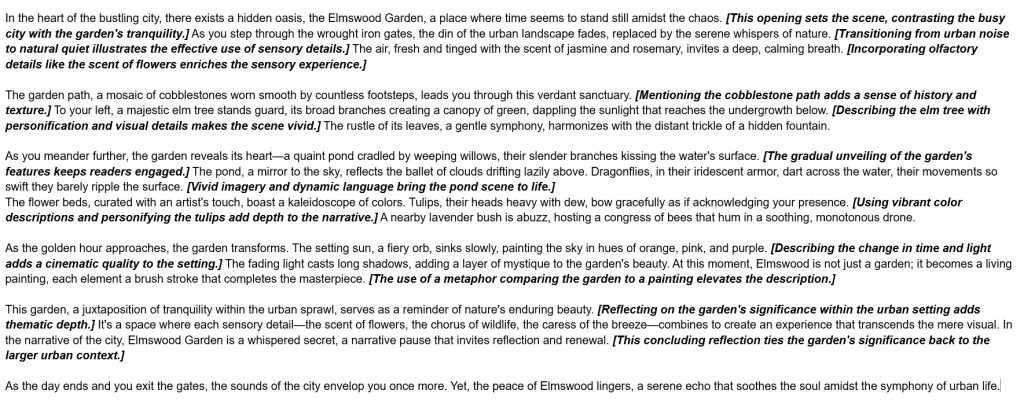Starting a descriptive essay is an opportunity to share your world, turning personal experiences and observations into vivid narratives. This guide will help you master the art of descriptive writing, from choosing engaging topics to using sensory details that make your descriptions come alive. We’ll explore advanced techniques for creating immersive settings and polishing your writing for clarity and impact. The goal is to not just describe but to transport your readers into the heart of your story.
Let’s embark on this journey, ready to transform a blank page into a captivating story that resonates with readers.
Descriptive vs. narrative essays: Key differences
When navigating through the realms of writing, it’s important to differentiate between two compelling genres: descriptive and narrative essays. Each genre uses words to paint clear pictures, but their main goals and methods are different:
| Aspect | Descriptive essay | Narrative essay |
| Focus | Provide a detailed snapshot of a person, place, object, or event, engaging the reader in a vivid sensory experience. | Focus on storytelling, featuring characters, a storyline, and the development of the narrative. |
| Techniques | Employ extensive sensory details and rich descriptions to make the subject come alive. | Tell stories that may include dialogue, character development, and conflict resolution. |
| Tone variations/ purpose | Can be personal, sharing a unique experience; formal, offering an objective definition; or impressionistic, evoking emotions and moods. | Explore themes and convey messages through personal experiences or made-up stories. |
| Objective | Captivate the reader by capturing the essence and atmosphere of the subject. | Engage the reader by unfolding a story that offers entertainment, insights, or moral lessons. |
While both styles enrich their prose with descriptive language, the distinction lies in their end goals: descriptive essays seek to “show” the reader a moment or subject in vivid detail, whereas narrative essays “tell” a story that seeks to connect and resonate on a deeper emotional or intellectual level.
Exploring descriptive essay styles
Descriptive essays can take on various forms, each offering a unique perspective and approach to storytelling:
- Personal narrative. This style delves into significant personal experiences, offering insights into the profound effects on the writer’s life. It’s intimate and reflective, inviting the reader to share in the author’s journey.
- Objective description. Here, the writer provides clear details about the subject without personal bias, much like providing factual information without any emotional overlay.
- Impressionistic narrative. This style uses vivid language to spark emotions or set a mood, drawing readers into a scene filled with the writer’s detailed descriptions.
The power of sensory detail
In a descriptive essay, using the five senses is key to creating engaging experiences. Effective use of sensory detail not only brings your narrative to life but also strengthens the connection with your audience. Consider the following when integrating sensory descriptions:
- Purposeful detailing. Ensure every sensory detail enriches your narrative, contributing meaningfully to the overarching theme or mood.
- Structured descriptions. Keep a logical flow in your descriptions. If describing a setting, move in an orderly way, like from the ground up or from inside to outside, to keep things clear.
Show, don’t just tell
Engaging readers requires more than just explaining; it calls for showing them the world through vivid, active language. Figurative language can be a powerful tool in this regard, offering creative ways to express ideas and emotions:
- Metaphors & similes. Use comparisons to reveal your subject in new ways, such as describing the quiet before a storm as similar to a hidden animal’s silent anticipation before it leaps.
- Personification. Give life to non-living things by describing them as if they could tell old stories or move with the gentle wind of spring.
- Avoiding clichés. Using creative language makes your writing interesting, but avoid common phrases. Seek unique descriptions to keep readers interested.
Incorporating these elements thoughtfully can transform a descriptive essay from a mere observation to a vivid, memorable experience that resonates with readers.

Choosing your descriptive essay topic
The heart of a descriptive essay lies in the topic you select. It should be something that deeply interests you, allowing you to dive into the fine details and share its essence with your readers. Here are some suggestions to get your creative juices flowing:
| Category | Suggestions |
| Objects | • A piece of jewelry with a story behind it. • An item that brings back fond memories. • A distinctive natural feature or plant in your environment. • A worn book that’s been passed down generations. |
| Places | • Your secret relaxation spot. • A place you visited that left a lasting impression. • A historical building in your town. • A bustling local market. |
| Events | • A challenging hike or outdoor adventure. • A meaningful personal milestone. • An unforgettable performance or event you attended. • The moment you overcame a personal fear. |
| People or pets | • A mentor who shaped your perspective. • An encounter with a stranger that left an impact. • A family member or friend you deeply care about. • A day in the life of your pet, from their perspective. |
The role of research in enriching your essay
With a well-chosen topic in hand, the next step is to add depth and credibility to your essay through detailed research. Exploring the history, cultural significance, or unique features of your chosen subject can reveal detailed insights, making your story more engaging. For example, if you’re describing an old building, finding out its stories and facts can add an interesting layer to your description, making your essay not just about describing a scene but also sharing a story that connects.
Why it matters
Writing descriptive essays sharpens your attention to detail and improves your expressive abilities. By engaging yourself in the specifics, you learn to convey your perceptions vividly, offering readers a peek into your experiences and perspectives. This practice not only sharpens your writing skills but also encourages a deeper appreciation for the nuances of the world around you.
Improving descriptive essay language
After selecting a compelling topic for your descriptive essay and conducting thorough research, the success of your writing depends on how clear and vivid your language is. This section offers strategies to refine the language of your descriptive essay, turning straightforward descriptions into rich, sensory experiences that resonate with readers. Here are some suggestions on what’s important:
- Careful use of senses. The core of a descriptive essay is how it uses details related to the senses. It’s important to use these details carefully. For example, in a descriptive essay about a peaceful garden, focus on the sound of rustling leaves and the smell of flowers to make your readers feel like they are in the garden.
- Using comparisons for vivid images. In a descriptive essay, using comparisons like metaphors and similes helps add creativity and depth. You could describe a sunset as if it were an artist’s canvas, brushed with pink and orange.
- Varying sentence length for flow. The rhythm of your descriptive essay comes from how you arrange your sentences. Mix up short, powerful sentences with longer, more detailed ones to make your writing more engaging and varied.
- Using active voice for clear images. It makes your descriptions more direct and lively. Instead of using passive phrases, choose active ones that bring the scene closer to the reader, such as “She savored the rich flavor of the chocolate cake.”
- Specific details for clear imagery. In a descriptive essay, specifics matter. Rather than a generic description, focus on the minute details that make the scene unique, such as the complex patterns on a butterfly’s wings.
- Sharing emotions with descriptive words. The main goal of a descriptive essay is to make readers feel something. It should not only show a picture but also make readers feel the calm or chaos you’re describing.
By applying these techniques, your descriptive essays will go beyond just showing pictures to telling stories that stir emotions and stay with your readers long after they’ve finished reading.

Structure of your descriptive essay
A well-organized structure is key to a compelling descriptive essay, typically including an introduction, body paragraphs, and a conclusion. Here’s a breakdown of each section to guide your writing process:
Introduction
- Hook. Start with something engaging to capture your reader’s interest. This could be an intriguing fact, a question, or a quote related to your descriptive essay topic.
- Subject introduction. Connect your hook to the main topic of your essay, providing a smooth transition for your readers.
- Thesis statement. Conclude your introduction with a clear thesis statement that outlines the focus of your essay.
Body paragraphs
- Paragraph structure. Generally, seek for at least three body paragraphs. Each should spotlight a different aspect of your thesis, adding depth to your descriptive essay.
- Detail and development. Use vivid sensory details and descriptions to bring your essay to life. Ensure each paragraph supports and expands on your thesis.
- Transitions. End each paragraph with a transition that seamlessly leads to the next point or the concluding section.
Conclusion
- Summary. Recap the main points of your essay, repeating how they support your thesis without introducing new information.
- Final impression. Your conclusion should leave a lasting impact, reinforcing the emotional or intellectual effect of your essay on the reader.
Creating engaging settings in descriptive essays
Turning the backdrop of your descriptive essay into an engaging setting goes beyond merely describing what’s visible; it’s about making the environment spring to life for your readers. Here’s how to enrich your settings:
- Purposeful details. Every element should serve a role. Rather than just noting a forest’s darkness, illustrate how its shadows could be covering outdated mysteries, adding a layer of intrigue.
- Setting as a character. Treat the environment like it’s a participant in your narrative. For instance, a lively street is overflowing with stories, each shop and every person walking by contributing to its unique character.
- Sensory immersion. Engage all the senses to draw readers into the scene. Describe not just the visuals but the rustle of leaves, the scent of fresh rain, the briny taste of the sea, the warmth of sunlight, and the vibrant hues of the sunset.
- Dynamic settings. Environments evolve with the day, weather, and seasons. Reflect these transitions to add depth; a serene garden by daylight might transform into a mysterious space under the moon.
- Cultural and historical depth. Contextualize your setting. An old town street isn’t just a series of buildings but a living mosaic of history, each element with its own backstory.
- Emotional connection. Unite the environment with the narrative’s mood. A stormy sea could reflect personal turmoil, while a peaceful meadow might signify calmness.
Incorporating these elements will transform the settings in your descriptive essays from mere backdrops to immersive environments that resonate with readers, thereby improving the emotional and thematic depth of your work.

Example of a descriptive essay
As we explore the art of descriptive writing, it’s essential to see theory put into practice. The following example illustrates the principles we’ve discussed, from engaging the senses to creating immersive settings. Notice how each sentence is prepared to not only describe the scene but also evoke emotion and atmosphere:

This example illustrates the power of descriptive writing to transport readers to another place and time, creating a vivid, sensory-rich experience. By carefully selecting details and preparing each sentence with purpose, the writer transforms a simple garden visit into a memorable journey. As you work on your descriptive essays, consider how you can apply these techniques to bring your own subjects to life, making them resonate with your readers.
Revising for clarity and impact
As we approach the final stage in preparing your descriptive essay, revising for clarity and impact becomes paramount. This crucial step is more than mere proofreading; it’s a comprehensive process to refine your language, improve your descriptions, and ensure your essay not only captures the essence of your subject but deeply resonates with your readers. Below are strategies to guide you through this vital phase, ensuring your descriptive essay achieves its fullest potential:
- Clarify your vision. Revisit the core purpose of your essay. Every element—from individual words to entire paragraphs—should contribute to the main impression you wish to leave on your reader. Remove any content that clouds this vision.
- Improve descriptive language. Seek opportunities to replace vague adjectives with vivid, specific descriptions. For instance, rather than a “beautiful garden,” describe a “lush, vibrant garden, alive with a riot of colors and scents.”
- Vary sentence structure. Introduce a mix of short, punchy sentences and longer, flowing ones to keep the reader engaged and control the narrative pace. This variety adds rhythm and dynamism to your writing.
- Focus on the show, don’t tell. Wherever you find yourself simply informing the reader, revise to show through rich sensory details and actions. Transform “The sunset was breathtaking” into “The horizon blazed with a symphony of oranges and pinks as the sun dipped below, igniting the sky.”
- Seek professional feedback. Take advantage of our platform’s document revision service for expert advice on improving your essay. Our editors can correct grammatical, stylistic, and punctuation errors, offering suggestions to strengthen your narrative and ensure it captivates and resonates with your audience.
- Read aloud. Listening to your essay can help you spot awkward wording, unnecessary repetition, and breaks in the flow. If you stumble or get bored while reading, those parts probably need some work.
- Ensure consistency. Make sure the tense, point of view, and writing style in your essay remain the same from start to finish. Changes in these areas can confuse readers and lessen the effect of your essay.
Conclusion
| Embarking on your descriptive essay journey opens up a world where words shape rich landscapes and emotions. This guide has offered you valuable advice to select compelling topics, effectively use sensory details, and refine your writing for maximum impact. Remember, the power of your essay lies in its ability to transport readers into the world you describe. As you bring your stories to life, keep in mind the importance of clarity and depth in your descriptions. Our document revision service is here to assist in perfecting your work, ensuring it resonates deeply with your audience. Now, with these tips in hand, unleash your creativity and turn your insights and experiences into engaging stories. Let your essays become gateways to the worlds only you can reveal. |
